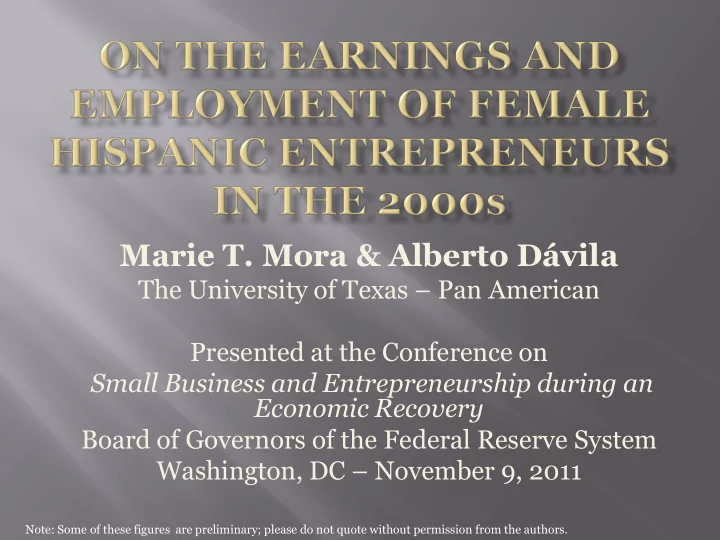

Marie T. Mora & Alberto Dávila The University of Texas – Pan American Presented at the Conference on Small Business and Entrepreneurship during an Economic Recovery Board of Governors of the Federal Reserve System Washington, DC – November 9, 2011 Note: Some of these figures are preliminary; please do not quote without permission from the authors.
Why is the topic of Hispanic entrepreneurship important? Hispanics represented one out of every six people in the U.S. in 2010, up from one out of eight a decade earlier. With this growth has come a sharp increase in the number of Hispanic-owned businesses. The SBO shows that the number of Hispanic- owned businesses rose by 43.7% (from 1.6 to 2.3 million), from 2002-2007).
Figure 1: Representation of Hispanics in the Workforce and among the Self-Employed 14 % Hispanics among All Workers Representation of Hispanics 12 % Hispanics among Self-Employed 10 8 2000 2002 2004 2006 2008 2010 Year Source: Authors' estimates using PUMS and ACS data in the IPUMS. Note: The sample includes workers ages 25-64, not living in group quarters.
The disproportionate growth of Hispanics in the entrepreneurial sector directly stems from their rising presence in the U.S. workforce as well as strengthening entrepreneurial tendencies within the Hispanic population— even during the recession. Why focus on Hispanic women? The rapid growth in the number of Hispanic entrepreneurs in the first decade of the 2000s was driven by immigrants, particularly women.
Figure 2: Economic Growth and Self-Employment by Gender and Hispanic Ethnicity 4 Economic Growth Rate 2 0 -2 -4 2000 2002 2004 2006 2008 2010 Year Source: BEA data on the annual % change of real GDP from previous year. 16 14 Self-Employment Rate Non-Hispanic Men 12 Hispanic Men 10 Hispanic Women 8 Non-Hispanic Women 6 2000 2002 2004 2006 2008 2010 Year Source: Authors' estimates using PUMS and ACS data in the IPUMS. Note: The sample includes workers ages 25-64, not living in group quarters.
Figure 3: Unemployment and LFP Rates by Hispanic Ethnicity and Gender 12 Unemployment Rate 10 Hispanic Women 8 Hispanic Men Non-Hispanic Men 6 Non-Hispanic Women 4 2000 2002 2004 2006 2008 2010 Year Source: Authors' estimates using BLS data. 80 Hispanic Men 75 LFP Rate Non-Hispanic Men 70 65 Non-Hispanic Women 60 Hispanic Women 55 2000 2002 2004 2006 2008 2010 Year Source: Authors' estimates using BLS data.
Hispanics appear to be creating employment opportunities, at least for themselves, during a time of weak labor markets. This raises two related questions. - What are the implications for their earnings? (Consider skill-adjusted earnings.) - Are they hiring others? (Consider rates of micro entrepreneurship.)
Figure 4: Self-Employment Earnings Penalties by Hispanic Ethnicity and Gender 0 Self-Employment Earnings Penalty Hispanic Men Non-Hispanic White Men -20 Hispanic Women -40 Non-Hispanic White Women -60 2000 2002 2004 2006 2008 2010 Year Source: Authors' estimates using PUMS and ACS data in the IPUMS. Note: The sample includes workers ages 25-64, not living in group quarters. See text for penalty definition.
Figure 5: Self-Employment Rates and Penalties among Hispanics, by Gender and Birthplace 12 Hispanic Immigrant Women Self-Employment Rate Hispanic Immigrant Men 10 U.S.-Born Hispanic Men 8 6 U.S.-Born Hispanic Women 4 2000 2002 2004 2006 2008 2010 Year Source: Authors' estimates using PUMS and ACS data in the IPUMS. Note: The sample includes workers ages 25-64, not living in group quarters. 0 Self-Employment Earnings Penalty Hispanic Immigrant Men -10 U.S.-Born Hispanic Men -20 -30 Hispanic Immigrant Women -40 U.S.-Born Hispanic Women -50 2000 2002 2004 2006 2008 2010 Year Source: Authors' estimates using PUMS and ACS data in the IPUMS. Note: The sample includes workers ages 25-64, not living in group quarters. See text for penalty definition.
Figure 6: Representation of Microentrepreneurs among the Self-Employed % Microentrepreneurs of the Self-Employed 100 95 Hispanic Women 90 Hispanic Men Non-Hispanic Women Non-Hispanic Men 85 2000 2002 2004 2006 2008 2010 Year Source: Authors' estimates using CPS data in the IPUMS. Years shown are for the year prior to the CPS. Notes: Self-emp. workers ages 25-64 are included; microentrepreneurs have fewer than 10 employees. % Microentrepreneurs of the Self-Employed 100 95 U.S.-Born Hispanic Women Hispanic Immigrant Women 90 U.S.-Born Hispanic Men Hispanic Immigrant Men 85 2000 2002 2004 2006 2008 2010 Year Source: Authors' estimates using CPS data in the IPUMS. Years shown are for the year prior to the CPS. Notes: Self-emp. workers ages 25-64 are included; microentrepreneurs have fewer than 10 employees.
Summary and Concluding Remarks Foreign-born Hispanic women represent one of the fastest growing entrepreneurial populations in the U.S., even in a weak economy. Locally-based initiatives to promote minority and female entrepreneurship could have larger effects on employment and tax revenues than in previous time periods.
Still, much of the Hispanic small business growth has been at the microentrepreneurial level (particularly among women), which has its own implications. Perhaps existing policies and programs aimed at helping small businesses grow can be improved to assist newly formed Hispanic- owned micro-businesses.
Other policies to consider include more traditional approaches, such as increasing access to education and enhancing English- language proficiency (among immigrants). These human capital investments should, in turn, enhance entrepreneurs’ strategic planning capacities and access to credit— important factors in the success of small businesses.
Recommend
More recommend